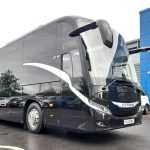The Bova name was for decades an established part of the coach industry, starting with the Europa and moving on to the Futura and Magiq before being absorbed by VDL. We look back to where it all began
Integral coaches are common in today’s industry, and they can trace much of their origin to the European imports of the late 1970s and early 1980s. Among those trailblazers was the Bova Europa, just one of which is known to survive in right-hand drive form.
The Europa is a significant, if slightly forgotten, part of coaching history. It was superseded by the iconic Futura, which proved hugely successful and long-lived. The Futura became one of the industry’s most endearing designs and it has almost completely overshadowed the Europa.
Yet thanks to one Yorkshire operator, the Europa is still just about on the radar. Last year, Keith Meynell of Barnsley-based operator KM Motors purchased the survivor, which had been part of a well-known collection of classic coaches.
Although KM Motors never ran a Europa, Keith speaks highly of its successor. Several Futuras remain in KM’s fleet, where they are used on domestic tour work alongside newer coaches. Their DAF engines are a major attraction and those power units are installed across KM’s fleet.
In conjunction with Darren Critchley of Odyssey Coach Sales, Keith made the Europa available recently for a routeone heritage Test Drive.
A true classic
No expense has been spared in returning the Europa to what is a state perhaps even better than it was in when it rolled out of the factory in Valkenswaard. It was first registered on 10 May 1983, and its almost 36 years have been washed away by a comprehensive restoration.

The coach carries Bova’s demonstrator colours, but it was not new in that application. Instead, it was delivered to Hunstanton operator Birds Coaches before moving to Fords of Althorne, where it’s likely to have served around for 20 years.
At that point, scrap beckoned. Instead, it was saved and restored to showroom condition. More recently, it moved to KM Motors. While Keith is open to selling it to another operator that will cherish it, the coach will be kept until the right purchaser is found.
Although it has done a lifetime’s work, the Europa will not have been subject to the same punishment as some other Bovas that were delivered at around the same time. Those coaches were used on scheduled work, where in some cases they covered on average more than 1,000km per day – an indication of the type’s durability.
Put to the test
As part of an occasional series on classics of the coaching industry, routeone was able to put the Europa through its paces recently. It shares one obvious thing with most of today’s integral coaches: Its driveline characteristics. It has a DAF engine and a ZF gearbox.
The former is a six-cylinder, 8.25-litre DHU-825. It develops 230bhp and 775Nm of torque; both figures are modest when compared to the MX-11 and MX-13 of today, but they stood up well to British coaches of the early 1980s.
Grunt is transmitted to the road surface by a manual gearbox with synchromesh. Although it has six speeds, the use of first is only required sporadically; it is a crawler, and second suffices in most circumstances.
Suspension is air-over-leaf and the coach weighs in at 10,240kg unladen. Its GVW is 15,300kg; that is evidenced by the Bova builder’s plate, which, like the dealer’s plaque noting that the coach was supplied by the Moseley group, is intact and undamaged.
An immaculate coach
Inside, the Europa is immaculate. Its 53 seats have been reupholstered and they all have legs that have been replaced and are thus free from rust. The floor is also in first-class condition, as is the glazing, which is thought to have been replaced during restoration.
Lap belts are fitted along with new antimacassars. The headlining has been replaced, as have the seatback ashtrays. Heater boxes are fitted and fresh air is introduced via passenger service units on the underside of the luggage racks.
In the cab, a couple of dials and gauges – including the temperature gauge – do not work, but other than that the driver’s area is in first-class condition. The seat has been recovered, as has that adjacent for the courier.
The radio – which by today’s standards is very basic – still functions properly, and the Plaxton-esque clock above the windscreen still tells the correct time.
Externally, the story continues in the same vein. All original badges are present along with polished wheel trims. The bodywork is in excellent condition and the top-hinged luggage locker doors and their mechanisms fit perfectly. The timbers within them have also been replaced.
On the road
Although the presence of a gear stick may be anathema to some younger drivers, it is not difficult to become accustomed to the Europa. A relatively light yet precise clutch action helps.
Unlike in some other older coaches, the linkages remain tight. That means the ‘throw’ between gears is minimal, and there is no play in the lever. As a result, selection is precise and not subject to the ‘shot in the dark’ gamble that is sometimes the case.
When that is combined with relatively close ratios and the way in which the engine quickly loses revs when the throttle is released, upshifts can be made rapidly. In fact, when lower down the ‘box it can be necessary to blip the throttle to avoid a lurch when the clutch is released.
When climbing hills, an early downshift is beneficial to maintain momentum. Again, a ‘blip’ is beneficial, although at no point when going up or down the gearbox is doubling the clutch necessary. Rushing third gear can lead to a slight grinding, but that is avoided with care.
What quickly becomes clear is that, unlike the larger DAF engines of today, the small unit needs to be worked hard, particularly in undulating terrain.
Its governed speed is 2,400rpm and it is necessary to take the power unit almost to the rev limiter before upshifting on an ascent. It is rather smoky when cold, but such an enthusiastic driving style encourages it to reach operating temperature quickly, at which point the exhaust clears.
Brakes are excellent, and they compare well with any modern coach’s. An exhauster is by the driver’s left foot, and while it was not possible to test its effectiveness, it’s likely that with the engine’s modest displacement a lot of revs will be required for it to work effectively.
Visibility from the cab is very good. Naturally, the Europa was designed before R66 rollover regulations were thought of, and it thus has comparatively thin pillars.
The A-pillar is pulled back slightly, demonstrating that such a practice is nothing new despite it having come to prominence on modern coaches in recent years.
In the cabin
Accompanied by Darren and Keith, routeone was able to take in the cabin experience as well as driving the Europa. What is uncanny is the lack of rattles or squeaks.
Although the coach has been parked undercover since retirement, it did around 20 years’ work beforehand. That is not reflected internally, and the Europa could quite easily challenge for trophies on the rally circuit if desired.
Keith is correct when he points out that the Bova has more in common with the coaches of today than those from the same period that were entirely British built. It rides smoothly and it is relatively quiet, even when being worked hard.
Although the Europa’s manual gearbox means that more care is required than with the automatic and automated models of today, the powerful brakes and easy steering make it otherwise simple to pilot.
Its engine needs to be revved, but that is to be expected with a small displacement and modest torque output. Even under these circumstances, the coach remains composed and collected – but given that there is a traceable link between the Europa and the VDL Futura 2 of today, that’s not surprising.
A modern-day classic
The industry is blessed with several classic coaches that have been restored to at least the condition they were in when they left their respective factories decades ago.
What is thought to be the sole-surviving right-hand drive Europa is one of them.
It is a stunning example of an early integral. Not only that, it is part of the story of the industry and its move away from domestic chassis to coaches that were built at least partially abroad.
It also demonstrates the longevity of the DAF/ZF driveline. It’s over three and a half decades since the combination arrived here, and it has remained a constant on Bova and VDL chassis since the days of the Europa.
While not the first foreign-built engine and gearbox coupling in the UK coach market, like those other early newcomers from Mercedes-Benz, Scania and Volvo, it showed that it had what it took to become an established part of the landscape.

























